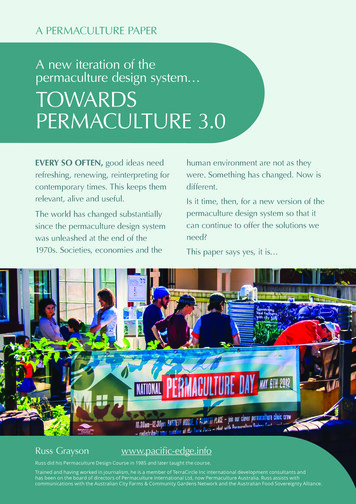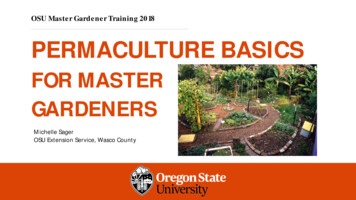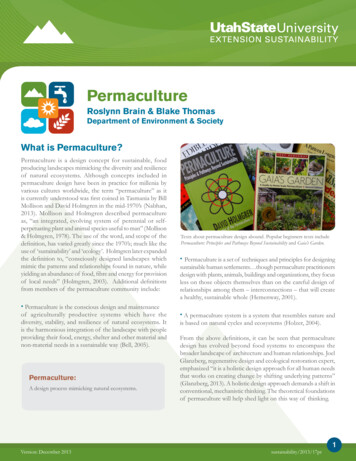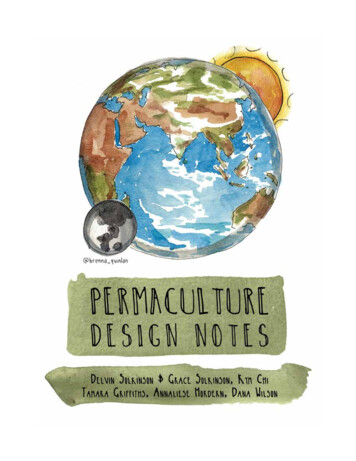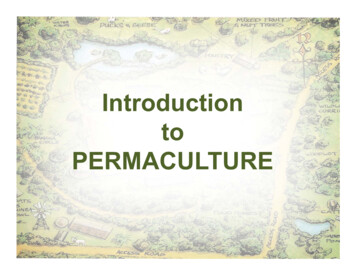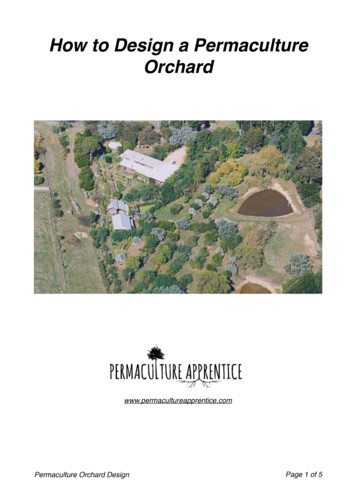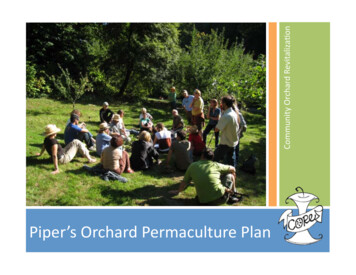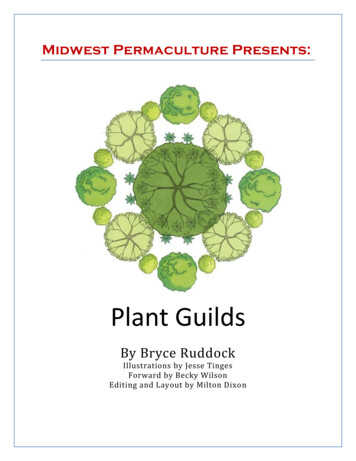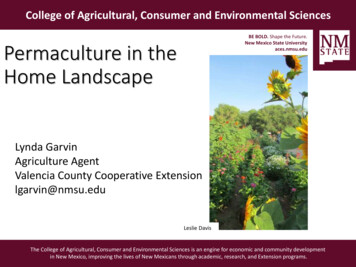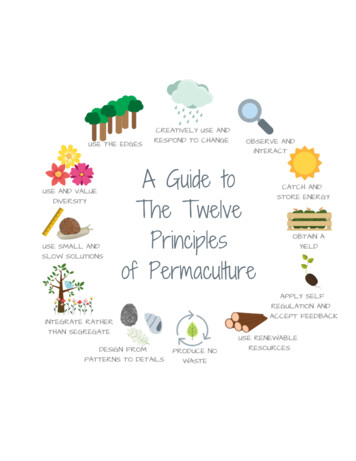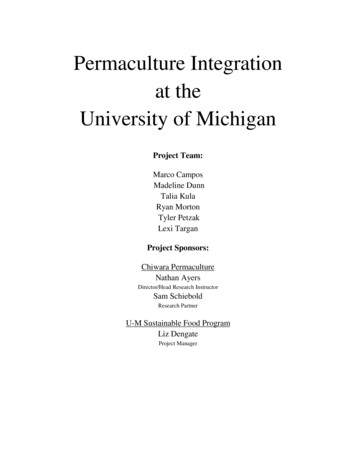
Transcription
Permaculture Integrationat theUniversity of MichiganProject Team:Marco CamposMadeline DunnTalia KulaRyan MortonTyler PetzakLexi TarganProject Sponsors:Chiwara PermacultureNathan AyersDirector/Head Research InstructorSam SchieboldResearch PartnerU-M Sustainable Food ProgramLiz DengateProject Manager
Permaculture IntegrationPage 1 of 23Table of Contents1.0 Executive Summary .22.0 Project Objectives 33.0 Introduction .33.1 Project Background .33.2 Permaculture Training 43.3 Existing Projects at Other Universities .54.0 Methodology .65.0 Findings .85.1 Student Interest at Diag Day Event 85.2 Faculty and Staff Interviews . . . . . 86.0 Recommendations .106.1 Satellite Garden .106.2 Chiwara Involvement at U-M .146.3 Interdisciplinary Capstone Course .157.0 Conclusions/Lessons Learned .178.0 Appendix .188.1 Satellite Garden Site Recommendation Photographs 188.2 Permaculture Certification Course . 219.0 Works Cited 22
Permaculture IntegrationPage 2 of 231.0 Executive SummaryPermaculture is an ecological design science modeled after natural ecosystems and based onethical principles. It attunes those who study it to the patterns inherent in natural systems, whichare used as a lens in solving current societal problems. Permaculture has enormous potential tobuild more efficient and enriching food, energy, and water systems for the University ofMichigan that are symbiotic with nature. This would allow the University community to livewithin the patterns of abundance that already exist in nature, thereby going beyond sustainabilityto create a regenerative campus. The 12 Permaculture Principles, if integrated into theUniversity, would decrease irrigation, fertilization and waste management costs while providingan enriching and educational experience for faculty, students, and staff. Permaculture integrationwill help the University attain its sustainability goals in climate action, waste prevention, healthyenvironments, and community awareness (Planet Blue, 2011).The following is a list of recommendations for the University of Michigan Sustainable FoodProgram and Chiwara Permaculture that indicates how permaculture can be integrated into theUniversity of Michigan. These recommendations are derived from research and interviewsconducted by students enrolled in Environment 391 - Sustainability and The Campus:1 The establishment and maintenance of a satellite garden is crucial to the integration ofpermaculture on campus. The following sites are possible satellite garden locations basedon visibility, feasibility, utility, and applicability of permaculture principles.a Northeast of Dana Building, West of CC Little Science Buildingb Northeast of the Exhibit Museum of Natural Historyc North of the Museum of Art, South of Tisch Halld North of the Museum of Art, South of Tisch Hall2 The UMSFP should work with Chiwara on co-curricular educational programming.a A lecture series by Nate Ayers on the 12 Permaculture Principles and how theycan be implemented at the University of Michigan will target students fromvarious schools and departments and will be sponsored by the UMSFP.b Hands-on student workshops organized by the Permaculture Design Team andheld at the Chiwara Permaculture Research and Development Lab in Ann Arbor.3 The creation of an interdisciplinary capstone course that promotes permacultureprinciples and cultivates further involvement in sustainable food efforts on campus.a The following faculty members that have expressed interest in such a course:Raymond De Young (SNRE/LSA Program in the Environment), Joseph Trumpey(SNRE/School of Art & Design), and Rebecca Lange (LSA Earth &Environmental Sciences).The next steps of this project include meeting with Sue Gott, the University Planner, in order tosecure a location for a satellite garden, holding a round table with the professors interested inbeing involved with the interdisciplinary capstone course, and the possible continuation of thisendeavor as an Environment 391: Sustainability and the Campus project during Winter 2013.
Permaculture IntegrationPage 3 of 232.0 Project ObjectivesOur sponsors asked for recommendations for how to integrate the permaculture design principlesinto the University’s sustainable food efforts by creating more hands-on, complex-systemslearning experiences for students and staff. Through consultation with the sponsors wedeveloped the following four deliverable objectives for the project:1 Recommendations for possible locations for a pilot permaculture satellite garden.2 Recommendations for how Chiwara Permaculture can have a presence on the Universityof Michigan campus.3 Recommendations for how Permaculture Ethics and Design Principles can beincorporated into existing curricula and new courses that could be created.4 An educational presentation that teachers and students can use to educate themselves andothers on the Principles and Ethics of Permaculture with examples that apply to theUniversity.The long-term goal is to educate students about food production that does not harm the earth andtraditional methods of growing food. Chiwara Permaculture and the U-M Sustainable FoodProgram are working to educate current and future generations in sustainable food production.These efforts are in conjunction with President Mary Sue Coleman’s Sustainability Goalsincluding: “the purchase of 20% of U-M food in accordance with U-M Sustainable FoodPurchasing Guidelines by 2025” and “to educate our community, track behavior, and reportprogress over time” (Planet Blue, 2011).3.0 Introduction3.1 Project BackgroundThe University of Michigan has an expansive selection of theory-based courses from whichstudents can choose from to enhance their educational experience. In addition, the University’sfocus on research provides the opportunity to integrate theory into practical applications.Permaculture presents the opportunity to apply theoretical knowledge in a living laboratory,which will provide students with more hands-on, systems-based learning in order to developskills that will help solve pressing environmental problems that are becoming ever morecomplex.The sponsors of this project are the U-M Sustainable Food Program and Chiwara Permaculture.These are the mission statements of our sponsors:U-M Sustainable Food Program“Fostering collaborative leadership that empowers students to create a sustainablefood system at the University of Michigan while becoming change agents for avibrant planet.”
Permaculture IntegrationPage 4 of 23Chiwara“Chiwara Permaculture is a Michigan based research, education, design andincubation firm. We research, design and educate permaculture solutions in 6main areas: Food, Energy, Water, Building, Transportation and Waste. We offerthree tiers of educational programming: K-12, College/University, andProfessional. We believe that permaculture is a powerful vehicle for STEM[Science Technology Engineering Math] education and problem based learning.To that end, we combine our research work with our educational programs, inpursuit of innovative solutions to community problems. Our best ideas areincubated and shared, toward ecological economic development. Our mission,guidance, and business practices are found within the Permaculture principles andethics. We promote small scale, community based solutions.”Our sponsors stressed the importance of obtaining a permaculture “lens” which would allow usto properly locate sites for a satellite garden and foster a discussion between group members,students, and faculty. We obtained this “lens” through a day-long intensive training inPermaculture Ethics and Principles, which took place on Tuesday, October 16th.3.2 Permaculture TrainingWe began our training at the Nichols Arboretum with a nature walk led by Nathan Ayers, ourproject sponsor and creator of Chiwara Permaculture. He used the many ecosystems existent inthe Arboretum to teach us the fundamentals of permaculture. We observed examples of closedloop systems, biodiversity, and the patterns that naturally exist in nature. Observation is vital topermaculture, as it uses biomimicry to duplicate systems that are found in nature. We alsolearned about plant fundamentals and why preserving biodiversity is vital to sustainability. NateAyers stressed that our agricultural dilemmas are issues of scale and that understanding andbeing able to duplicate nature’s stacked functions is key to fixing the system. Small and slowsolutions allow permaculture designers to consider all elements of a system and how theyinteract with each other when building new systems. These concepts are explained in the 12Design Principles of Permaculture founded by Bill Mollison and David Holmgren (Holmgren,2002):1Observe and Interact2Catch and Store Energy3Obtain a Yield4Apply Self-regulation and Allow Feedback (set limits to growth)5Use and Value Renewable Resources and Resources6Produce No Waste7Design From Patterns to Details8Integrate Rather than Segregate9Use Small and Slow Solutions
Permaculture IntegrationPage 5 of 23101112Use and Value DiversityUse Edges and Value the MarginalCreatively Use and Respond to ChangeUsing these Principles and the design techniques learned during the intensive training, wedeveloped the criteria for locating potential sites for a pilot satellite garden for the UMSFP’sCampus Farm. These criteria are explained in the Methodology section (4.0). The Principles areused to help us design in tandem with nature’s patterns. The UMSFP is already planning to usepermaculture methodology in the design of the Campus Farm. In addition, they would like tohave an educational satellite garden on campus that would function as a pilot Research andDevelopment Lab for high-yield, low-labor growing techniques. One of the advantages of apermaculture satellite garden is that it is a never-ending resource for research and education.3.3 Existing Projects at Other UniversitiesUniversity of Massachusetts: AmherstUMass Amherst is the nation’s leader in permaculture initiatives that are gaining massivemomentum and support (UMass Permaculture Committee, 2012). In 2010, students from theUMass Permaculture Initiative approached campus food services with a detailed proposal togrow food for the dining commons. According to Andrew Mack, their proposed budget was 10,000 for a ¼ acre space in front of the Franklin Dining Hall. This area had a high amount oftraffic and was visible to both the students and the community. This was an important componentin attracting enough interested volunteers to turn this idea into a reality. The first step taken wasgrowing fertile soil. The students used sheet mulching to regenerate and aerate the earth: thisincluded 1,200 pounds of organic matter, 500,000 pounds of university compost, recycledcardboard and mulch (UMass Amherst In the Loop, 2012).While the soil sat for five months, the UMass Permaculture Initiative held a design roundtablethat attracted over 100 community members and university students from across the nation. Thegroup was mainly comprised of undergraduates who created 40 different designs for the ¼ acrespace. Upon checking the soil, students found about eighteen worms per square foot with fungicolonies birthed throughout (UMass Amherst In the Loop, 2012). These are indicators that thesoil is rich in nutrients, which is the most vital aspect for a successful garden. The goal for thisspace was to provide food for the students and to be an educational hub for the entire community(UMass Amherst In the Loop, 2012).Over 1,000 volunteers planted a total of 150 different species of plants in a 3,500 square footspace, producing over 1,000 pounds of food in one year. Interest in permaculture spread quicklyon campus. Over 20,000 students, about 70% of the student body, became familiar with the termand could explain what permaculture is trying to accomplish. The students were so intrigued bypermaculture that the senior class of 2012 funded the newest garden project outside of BerkshireDining Hall with money raised by their class. The students understood that they should not just
Permaculture IntegrationPage 6 of 23be consumers, but also creators (UMass Amherst In the Loop, 2012). The enthusiasm and workethic that this project evoked was remarkable and can be replicated on other college campuses.Yale UniversityYale University is an example of a peer institution that is incorporating permaculture principlesinto its campus. The farm was established in May 2003, when the Yale Sustainable Food Projectwas initiated. Although this farm is not described as a ‘permaculture’ garden, it utilizes andincorporates many of the permaculture principles. Prior to the farm’s creation, this space wasoverrun by shrubs, weeds and several dying hemlock trees (Yale University, 2012). Students,staff and community volunteers came together and transformed this degraded plot to a fertile andproductive garden that produces a variety of edible plants. It was important for their team tocreate a garden that is beautiful, productive and sustainable (Yale University, 2012). They alsohave a chicken coop located next to a compost pile, which aids in the aeration of the organicmatter and speeds up the composting process. This is a model of a closed loop system; the outputof one system is the input of another. A native species section functions as a food forest with figtrees and medicinal plants. This is a key aspect of permaculture; native species require lessmaintenance and watering because they are adapted to local conditions. Yale’s utilization oftheir garden is similar to how UMSFP and the University of Michigan could use our proposedsatellite garden.4.0 MethodologyThe first part of our project was focused on learning about the elements of permaculture. Thiswas accomplished through the previously mentioned intensive training.The second part included developing recommendations for a satellite garden, integratingpermaculture into the University curriculum, and raising awareness about permaculture oncampus. In order to accomplish these goals, we identified faculty and staff whose field studieswere related to permaculture and/or had previously shown interest in Chiwara. Once key playerswere identified, we held interviews with them to obtain valuable information for ourrecommendations for the garden sites and integration of permaculture into curricula.The following criteria were used for identifying satellite garden sites:1. Determined using permaculture criteria: Sufficient southern exposure for adequate sunlight Between 1/10 and ⅛ acre to allow for enough space to implement permaculturepractices, but not more than can be properly maintained while the program is inits infancy2. Determined using our understanding of University practices: Visible to most of the campus population Ability to incorporate signage that is highly visible and demonstrative of thepractices being applied
Permaculture IntegrationPage 7 of 23 Easy access for Grounds and student volunteers for purposes of maintenance andcare Close proximity to water access OR a rainwater capture system for irrigationThe faculty interviews were conducted using the following topics as a general framework for thediscussions with key faculty about how to integrate permaculture into curricular activities: Their existing knowledge of permaculture and explained it if necessary How permaculture could be (or is) incorporated into what they already do If there are existing courses that teach elements of permaculture (and may not becalling it that) How changes in curriculum are implemented at UM Barriers to creating new curricular programs (i.e. courses, seminars, specialtopics, minors, etc.) How to make permaculture attractive and interesting to the campus at large Recommendations of other key players to interviewWhen interviewing Tracey Artley, Sustainability Programs Coordinator for Plant Building andGrounds Services, different questions were asked since this interview was to gain informationabout how best to implement a satellite garden. The questions were: How do we go about getting our voice heard? Given that the University of Michigan - Ann Arbor is not an explicitly agriculturefocused university like MSU, how do you see a campus satellite garden fittingwithin the University’s core mission? Have you heard any student interest for this kind of project before? What challenges do you identify with our project? Are there other contacts for consideration?Additionally, we successfully planned and hosted a Diag Day on Central Campus, where wehanded out “green smoothies” (made out of apple and kale) to students while explaining thebasics of closed-loop systems. We used a stationary bicycle connected to a generator thatpowered LED lights that would grow kale, hence allowing the user to consume it and gainenergy to re-start the whole cycle. This event was used as a means for us to gage interest amongstudents and staff and to increase awareness about permaculture. We wanted to see how peoplereacted when informed of the basic idea of permaculture and systems thinking.Lastly, we created a presentation on the 12 Permaculture Principles. This presentation wasprepared on prezi.com, a website that allows for information to be presented as a visual storywith flow and narrative. This presentation format mimics the way permaculture urges us to thinkabout and imitate nature.
Permaculture IntegrationPage 8 of 235.0 Findings5.1 Student Interest at Diag Day EventAs mentioned above, the purpose of our Diag Day was to increase permaculture awareness onthe University of Michigan campus and gage student interest. We talked to students about thebenefits of permaculture designs, and we demonstrated a closed-loop system in action.Moreover, we collected signatures for a petition in support of the sustainable food program’seffort to implement an educational satellite garden on campus. The purpose of the petition wasnot for official use but rather to gauge student interest and passion for the implementation ofsuch ideas. We found that there is interest among students in learning more about this subject.5.2 Faculty and Staff InterviewsIn order to start gathering information on how to approach this project, we met with TracyArtley, the Sustainability Programs Coordinator for Plant Building and Grounds Services. Weasked her questions on what the first steps should be in order to obtain a land space for thesatellite garden. With her information we were able to identify possible options on campus, andcreate a list of “must haves” and “would likes” that the garden requires. Moreover, she pointedout previous teams that have worked on landscape redesign around campus that could be helpfulpeople to contact. We also identified some of the future challenges that our group may face, suchas who will be in charge of the garden in a few years and who will take care of it in themeantime. She also mentioned that the university is moving towards more natural lookinglandscapes because of costs, and finding a spot on Central Campus may be harder than finding aspot on North Campus. However, with enough support from faculty and staff, this project wouldhave a higher potential of continuing.Our next step was to identify key faculty members that would get on board with theinterdisciplinary capstone course. We sat down with Professor Raymond DeYoung from theSchool of Natural Resources and the Environment, and figured out current courses on campusthat are related to permaculture. Some of these are in urban planning, education and policyoffered by SNRE and Program in the Environment (LSA). However, if we were to reach out toother fields like humanities, international studies and even poetry programs, we could get newstakeholders involved in sustainability issues, which could lead to more people talking to thedeans. For example, faculty in engineering and business are interested in sustaining the health ofthe planet.Professor DeYoung mentioned that in order to reach new students and get them involved inpermaculture, it is necessary to create a precursory familiarity with the idea and to create anassociation between the word and its concept. For instance, students could see a smalldemonstration site, read about it in a poem, hear about it on campus, or read about it online. AsProfessor DeYoung mentioned, “the third time you see something is the time it clicks.” After thispreliminary exposure to permaculture, students who see a course being taught about the topic
Permaculture IntegrationPage 9 of 23will be more likely to take the class. Some courses are taught in a case based format, so anotherpotential publicity avenue is to use cases that talk about permaculture.Other options that Professor DeYoung suggested were to take one principle and use it as a preexisting solution for one aspect of the university instead of showing the whole system at once,which may be overwhelming. Students should be informed of the benefits of permaculture oncampus and point out where could it be implemented using small demonstration sites. Thestudents could then question why it is not being implemented yet and be compelled to ensure thatpermaculture is integrated into the University. He also recommended the creation of a Diagdemonstration pilot. The best way to approach this is to sit down with Grounds staff and askthem if it would be a feasible option.We also approached Professor Joseph Trumpey from the Stamps School of Art and Design. Healso agreed that Central Campus was a better location for the satellite garden because of theamount of students that walk around in a daily basis. Furthermore, Professor Trumpey seemedvery interested in supporting us in the creation of the interdisciplinary capstone course, andhelped us determine the first steps towards it. The first step is to identify the department thatwould host the class, identify specific faculty members that are interested, and obtain supportfrom the dean. Once this has been accomplished, a “special topics class” could be created. TheUniversity of Michigan is decentralized, and this requires us to approach each dean individually.However, the decentralized nature of UM will allow us to reach new frontiers and break a lot ofinstitutional barriers. He strongly recommended getting the students involved. After all, it is thestudents who have a bigger voice in this university, even more than the faculty.We were also able to meet with PhD student John Graham. John is focusing his dissertation inecological design of systems and agricultural restoration. He talked to us about his view ofpermaculture and inspired us to make our project more appealing to the public. For example, wecould start speaking about environmental ethics in order to get a wider audience, since socialresponsibility is a characteristic that every student should have. Learning the basics can makepeople feel empowered. With any kind of political or cultural movement, we must talk to peoplein their language. For example, if they value money, find out what that does for them. Hementioned Aldo Leopold, an ecologist and philosopher who published a book in 1949 laying outan ethical philosophy. Leopold wrote essays that say we need to extend ethical consideration tothe non-human community. We must include soils, animals, plants, and ecological processes inour ethical community. Since Leopold’s work, others have expanded this idea. Leopold's landethic should be an inherent ethical system of permaculture and of the university. This is aquestion of how our system holds power. We are a part of a community that extends beyond ourspecies. Therefore, we must extend our ethical responsibility beyond our “tribe.” Some of thechallenges we will face include the lack of peer-reviewed science attached to permaculturepractices and principles, examining ways of doing permaculture type activities on a larger scale,and raising awareness of what permaculture is.
Permaculture IntegrationPage 10 of 23Our interview with Professor Rebecca Lange, Chair of the Department of Earth andEnvironmental Sciences, reinforced what both professors previously expressed about studentinvolvement. Student initiatives and their commitment to their projects is what the campus needsfor this university to keep moving forward. Furthermore, professors should get involved in thisproject as well. This project serves as a good educational tool, where students can get involved ina more practical way. The capstone course can include trips to the satellite garden where “handson” activities can take place, and students can learn from a classroom as well as on the field. Thiscourse can also be designed to be interdisciplinary, where professors from different departmentscan give lectures throughout the course.6.0 RecommendationsThe following is a list of recommendations for the University of Michigan Sustainable FoodProgram and Chiwara Permaculture that indicate how permaculture can be integrated into theUniversity of Michigan.6.1 Satellite GardenThe University of Michigan Sustainable Food Program's [UMSFP] long-term plan for theUniversity includes the implementation of satellite gardens directly on campus. However, nofunding has been allocated towards this project thus far. The purpose of a satellite garden is toexpand the visibility of the Sustainable Food Program on campus and reach students thatnormally would not voluntarily visit the campus farm. The visibility of a student led garden iscrucial to the development of sustainable food awareness throughout campus. The campus farmhas attracted many students that are already excited about sustainable food systems, but in orderto engage those without this predisposition, a satellite garden is necessary.The Permaculture Design Team [PDT], a member organization of the UMSFP, is currentlyfocused on acquiring funds for the start up costs associated with the implementation of onesatellite garden. To help with this, Madeline Dunn, Co-Founder of the PDT, has applied for agrant from the Planet Blue Student Innovation Fund for 10,000. The anticipated outcome ofthis project is a student-operated garden that would embody the needs of communities located inclose proximity. For example, a garden by the School of Art and Design may grow fibers thatcan be harvested and dyed for student projects. The UMSFP already has had success in rallyingvolunteers for workdays at the Campus Farm. We anticipate an even higher level of studentengagement due to the easy access and visibility of the proposed satellite garden.We will be using permaculture methodology to design this garden. This means that it will be alow maintenance space that employs companion planting and polycultures to ensure a closedloop system. It will produce little to no waste and will need no synthetic inputs. The goal of thisgarden is not to feed the entire university, but rather to expose the university community to a newway of thinking about how land can be used and how to grow food. Further goals include
Permaculture IntegrationPage 11 of 23providing students with opportunities to volunteer and a source for research into alternative landuse solutions.Potential sites for the satellite garden have been chosen based on visibility and permaculturerequisites that were developed through our intensive training with Chiwara Permaculture.Having a site on Central Campus is crucial to student engagement. After conversing with thestudents in our group who take classes on North Campus, we have determined that a satellitegarden on North Campus may be rarely used and appreciated. This is not due to disinterest orapathy, rather to the ample time intensive majors located on North Campus. We have spokenwith many faculty and staff members regarding possible site locations and uses for a garden. Wespoke with Tracy Artley who told us that a project like this is innovative and likely to succeed.Meeting with Sue Gott, the head university planner, needs to be the next step in implementationof a satellite garden for the UMSFP.We will then work with the University Grounds staff to prepare the soil. The challenges inworking with grounds include the following: the sheer mass of campus land they have to coverand take care of, they are not necessarily an educational component of the University, theyalready have a logical system set in place and we are asking them to take care of a piece of landthat may be intensive for a few years. They have their job and they complete that based onrecommendations and order from a higher authority. This will vary depending on the sitelocation. Typically, an area is sheet mulched using recycled cardboard, mulch, and compost.After roughly five months, the soil can be tested and planting can begin. The PermacultureDesign Team will help create the design for the garden as well as evaluate the soil quality of thelocation.The UMSFP can measure the success of this project by keeping records of the official uses of thesatellite garden. This can be done through a guest book at the garden. For example, when ateacher uses the garden for a class project or when a student organization volunteers in thegarden we will document this usage. Also, the general student interest and engagement can bemonitored through periodically sending out surveys to the University population. In the long run,the garden will be an easy passing point during campus day tours or new student orientations.Site recommendations for a satellite garden include, but are not limited to the following:1 Northeast of D
permaculture satellite garden is that it is a never-ending resource for research and education. 3.3 Existing Projects at Other Universities University of Massachusetts: Amherst UMass Amherst is the nation’s leader in permaculture initiatives that are gaining massive momentum and suppo
